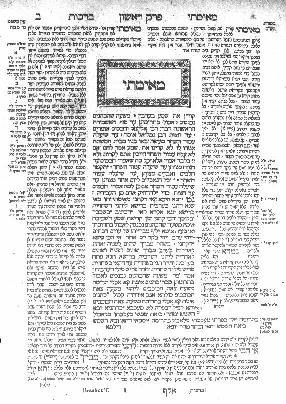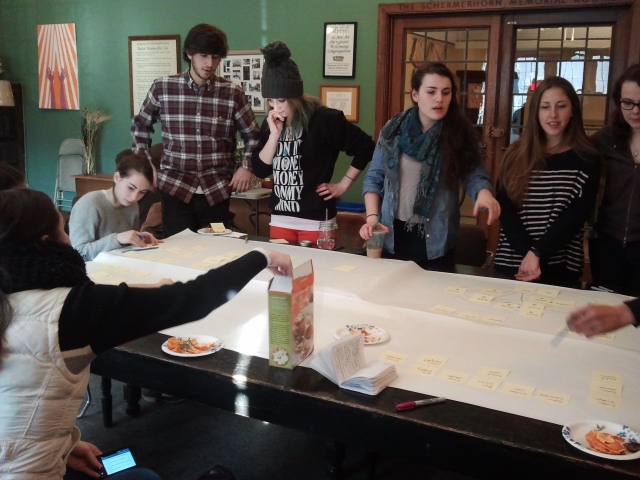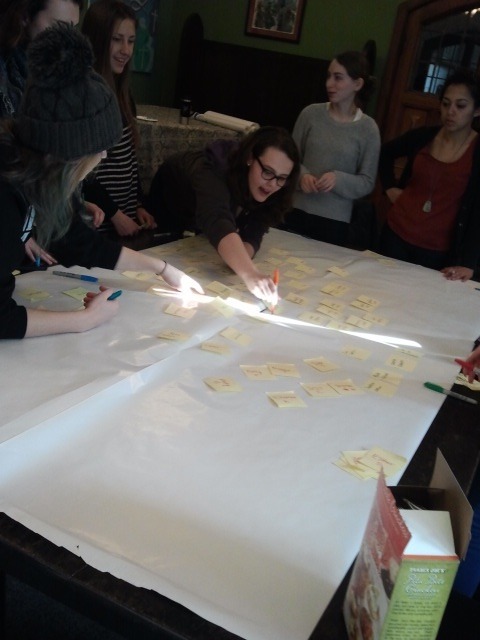Guest post by Laura Intfen, Member Services Coordinator at Congregation Beth Torah in Overland Park, KS
My pulpit rabbi, Rabbi Mark Levin, likes to tell this story: A young boy shares Shabbat dinner with his father, who is complaining, once again, about going to services the next day. “I don’t even know if I believe in God.” states the father. The young boy asks his father, “If you don’t go to talk to God, then why do you go to synagogue at all?” His father looked down at him and explained, “I go to synagogue each week with my old friend Shlomo. Shlomo goes to talk to God, and I go to talk to Shlomo.”
An age old problem for Program Directors, is guessing what gets people in our building. But, here we are in 2012, and now the question has changed. The future of modern Reform Judaism is not figuring out how to get people through our doors, but figuring out how to get people connected to each other.
As a Member Services Coordinator of a modern Reform Congregation, I am privileged to belong to the Program Directors of Reform Judaism. But I've learned from my colleagues that Program Directors have a variety of names and even a wider variety of duties. There are Community Coordinators, Directors of Family & Congregational life, Directors of Membership Engagement and Community Engagement Mangers.
As we communicate with each other and share ideas and goals, one thing is clear: building our programs in the traditional, top down, guess what people want, throw ideas against the wall and see what sticks method is not working. This is an expensive and antiquated way to serve our congregants. While many of the benefits of a synagogue can be found elsewhere (especially online), there is one thing we can uniquely offer: Community, where our members find recognition, validation and support. This is the tripod by which our programming must be built upon. One might call it "engagement programming". So here at Congregation Beth Torah, we have begun to program using the lens of engagement. To start the transition, we looked at our caring committee.
When you join Congregation Beth Torah, you are automatically part of our k’sharim (caring) Committee. Every single family unit is included. The entire congregational roster is divided by twelve. With approximately 650 families, this equals about 53 families per month. As a member of Beth Torah, you are part of a team for one month a year, and you are never alone. When there is a need in the congregation for a meal, or a ride, or attendance is needed to make a minyan at a shiva service, an email blast goes out to the 53 families on the team. Members of that month’s team contact each other, schedule with each other, and coordinate efforts with each other. Not only does this alleviate the problem of caring committee burn out by having the same people do everything, but our congregants in need get care and warmth from other members of the congregation AND the members of that month’s team form a functioning affinity group.
By connecting members outside of our building doing k’sharim work, they have much stronger connections when they happen to be in our building at worship. They already know each other (recognition), know the other person has done a caring deed for one of our members (validation) and has been offered a meeting place, here in our building to further their relationship with this other person (support). The purpose of our K’sharim committee is, of course, to care for our congregants. But our caring community has an additional goal: to connect people.
This is a true culture change for our congregation. What started with a Rosh Hashanah sermon by our rabbi, in which he asked our congregants to become citizens, and not be consumers, became a repurposing and reassessing of our current programs and an eye towards future programming. Our staff has created a mission statement to support this change in culture:
We are a visionary team carrying out the mission of the congregation. Through our dedicated team’s collaborative culture, we engage our various congregants and affinity groups to develop innovative ways to meet the needs of our congregational community. We will work, supported by the Board of Trustees, to accomplish these goals in the most creative, efficient and cost conscious means possible.
The results of this change have been immediate and amazing. Some programs have been discontinued. Every program must have at least ten participants. It is not up to me to come up with ten people, but up to whomever owns the program. We did not have a men’s club as of three months ago. I had a couple of men approach me about some activities for such a group. My response was to come up with at least eight more men and some program ideas and then I would meet with them. I am proud to say that a group of nearly 30 men met on a recent Monday evening in a member’s home for some smoked brisket, some football and some beer. But mostly they met to be a community.
Because more members are meeting more members, our worship numbers have risen. Our traffic in the building has actually increased with these groups and I love walking through our building and hearing a group of twelve people in a room discussing their interest in mystic Judaism next door to our 50 and More group planning their next book club meeting, next door to our Adult B’nei Mtizvah class. All the rooms contain more than ten people and all the rooms are starting places for new relationships. All the rooms are places where our members are recognized, validated and supported.
We have just begun our journey. As Program Directors, or Engagement Managers, or Member Services Coordinators, we have the exciting and challenging task of recognizing the affinity groups that organically arise, validating these groups as important to our congregants and supporting these groups through resources and expertise.
Laura Intfen is the Member Services Coordinator at Congregation Beth Torah in Overland Park, KS. You can find them on Facebook and Twitter.
 This post is part of a blog series on Connected Congregations being curated by Darim Online in partnership with UJA Federation of New York. Through this series, we are exploring what it means for synagogues to function as truly networked nonprofits. Connected Congregations focus on strengthening relationships, building community, and supporting self-organizing and organic leadership. They are flatter and more nimble, measure their effectiveness in new and more nuanced ways, allocate their resources differently, and use technology in a seamless and integrated way to support their mission and goals. We hope these posts will be the launching pad for important conversations in our community. Please comment on this post, and read and comment on others in the series to share your perspective, ideas, work and questions. Thanks to UJA Federation of New York for supporting this work.
This post is part of a blog series on Connected Congregations being curated by Darim Online in partnership with UJA Federation of New York. Through this series, we are exploring what it means for synagogues to function as truly networked nonprofits. Connected Congregations focus on strengthening relationships, building community, and supporting self-organizing and organic leadership. They are flatter and more nimble, measure their effectiveness in new and more nuanced ways, allocate their resources differently, and use technology in a seamless and integrated way to support their mission and goals. We hope these posts will be the launching pad for important conversations in our community. Please comment on this post, and read and comment on others in the series to share your perspective, ideas, work and questions. Thanks to UJA Federation of New York for supporting this work.
 I love talking about blogging because it ties in so well with Jewish sensibilities about content and conversation. The Talmud was, arguably, the first blog – a conversation that takes place across time and space, bringing in many voices, contradictory opinions, and preserving it all. Even the format speaks to this. If you’ve ever looked at a page of Talmud (and not gotten completely intimidated, as I usually do), the main content is at the center, the comments in chronological order reverberating out from there. Folks comment on the main idea, then comment on the comments, then comment on the comments’ comments… Ah, Judaism, the ultimate obsessive-compulsive book club.
I love talking about blogging because it ties in so well with Jewish sensibilities about content and conversation. The Talmud was, arguably, the first blog – a conversation that takes place across time and space, bringing in many voices, contradictory opinions, and preserving it all. Even the format speaks to this. If you’ve ever looked at a page of Talmud (and not gotten completely intimidated, as I usually do), the main content is at the center, the comments in chronological order reverberating out from there. Folks comment on the main idea, then comment on the comments, then comment on the comments’ comments… Ah, Judaism, the ultimate obsessive-compulsive book club.
 Enter a roll of butcher paper, post-its and some colored Sharpies: all the ingredients needed for a low-tech version of
Enter a roll of butcher paper, post-its and some colored Sharpies: all the ingredients needed for a low-tech version of 
 Lastly, the process of creating our network map was collaborative, iterative and fun. We plan to do it several more times throughout the length of the internship. Our prediction: as the people in our small communities forge connections with others in the overall network, these connections will create a density that will attract more and more students to the meaning, pleasure and fun of Jewish life at the University of Chicago.
Lastly, the process of creating our network map was collaborative, iterative and fun. We plan to do it several more times throughout the length of the internship. Our prediction: as the people in our small communities forge connections with others in the overall network, these connections will create a density that will attract more and more students to the meaning, pleasure and fun of Jewish life at the University of Chicago. I’ve recently found that Twitter has been enhancing my experiences at conferences and conventions. I joined the social networking site when I was at the URJ Biennial in 2009, as so many people seemed to be tweeting there. As I got ready for the CCAR Convention it wasn’t just about finalizing travel arrangements and packing clothes, it was also about identifying the hashtag (
I’ve recently found that Twitter has been enhancing my experiences at conferences and conventions. I joined the social networking site when I was at the URJ Biennial in 2009, as so many people seemed to be tweeting there. As I got ready for the CCAR Convention it wasn’t just about finalizing travel arrangements and packing clothes, it was also about identifying the hashtag ( A number of people were walking around the convention halls with QR codes stuck to their lapels (this was going to be one of the innovations being pushed at the CCAR). When scanned, these QR codes provided links to webpages, videos and information about the convention. And of course, from the very first session, Rabbis were tweeting about the convention. Services also took full advantage of technology as people were encouraged to lay down the siddur and pick up the iPad. With the
A number of people were walking around the convention halls with QR codes stuck to their lapels (this was going to be one of the innovations being pushed at the CCAR). When scanned, these QR codes provided links to webpages, videos and information about the convention. And of course, from the very first session, Rabbis were tweeting about the convention. Services also took full advantage of technology as people were encouraged to lay down the siddur and pick up the iPad. With the  And in some services you didn’t need an iPad, you didn’t even need a book, as the prayers were broadcast onto screens at the front of the room for everyone to follow. Visual t’filah meant that hands were free, heads were looking up, and our bodies were opened up to join together in prayer. And again Rabbis were tweeting. And in sessions, they demonstrated good practice; a few copies of Rabbi Arthur Green’s handout were distributed, but on the screens a link was given for people to download the handout, along with a QR code for the handout, and during the session, all Jewish texts were displayed on the two large screens on either side of the podium. And of course, Rabbis were tweeting.
And in some services you didn’t need an iPad, you didn’t even need a book, as the prayers were broadcast onto screens at the front of the room for everyone to follow. Visual t’filah meant that hands were free, heads were looking up, and our bodies were opened up to join together in prayer. And again Rabbis were tweeting. And in sessions, they demonstrated good practice; a few copies of Rabbi Arthur Green’s handout were distributed, but on the screens a link was given for people to download the handout, along with a QR code for the handout, and during the session, all Jewish texts were displayed on the two large screens on either side of the podium. And of course, Rabbis were tweeting.
 shared with colleagues on Twitter. And during the breakout sessions, I followed the session I was in, but I could also get a taste and flavor of the sessions I could not attend. I would love to hear what other people took away from the CCAR convention (whether they were there or following on twitter). But I am left with one final question: what happens to a hashtag (
shared with colleagues on Twitter. And during the breakout sessions, I followed the session I was in, but I could also get a taste and flavor of the sessions I could not attend. I would love to hear what other people took away from the CCAR convention (whether they were there or following on twitter). But I am left with one final question: what happens to a hashtag (



